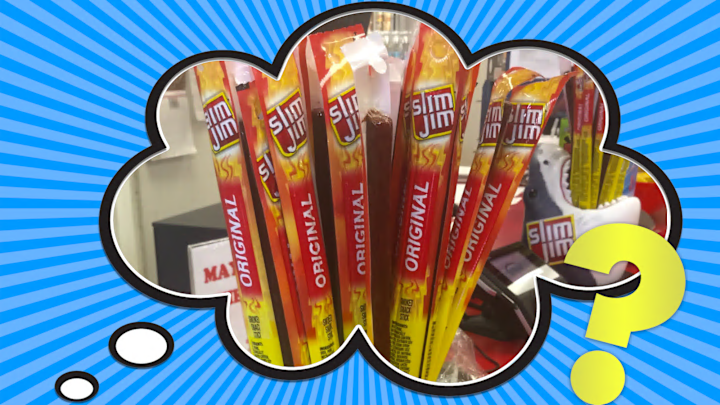Slim Jims are one of the few meat products sold outside the refrigerated aisle. Shaped like skinny tubes and packaged in individual, vacuum-sealed wrappers, the “smoked snack sticks” don’t resemble the body parts of any animal known to science. Slim Jims are made from real meat, but that meat goes through a long process to reach its snackable, shelf-stable form.
What’s in a Slim Jim?
ConAgra, the maker of the product, doesn’t keep the components a secret from consumers. The 17 ingredients listed on the back of every wrapper are as follows:
BEEF, PORK, MECHANICALLY SEPARATED CHICKEN, WATER, TEXTURED SOY FLOUR, CORN SYRUP, SALT, CONTAINS LESS THAN 2% OF: NATURAL FLAVORS, DEXTROSE, PAPRIKA AND EXTRACTIVES OF PAPRIKA, HYDROLYZED SOY PROTEIN, MALTODEXTRIN, LACTIC ACID STARTER CULTURE, BARLEY MALT EXTRACT, CITRIC ACID, SOY LECITHIN, SODIUM NITRITE.
Meat from three different animals accounts for the most prominent ingredients. While beef and pork are self-explanatory, the phrasing of “mechanically separated chicken” may give the reader pause. This USDA-official term describes highly-processed meat that’s been forced “under high pressure through a sieve or similar device” to separate soft tissue from the inedible bones. The process yields a batter-like paste that mixes meat with the less desirable parts of the bird like nerves, skin, organs, and the occasional bits of bone that sneak through. It’s used to make products like hot dogs and bologna in addition to gas station meat sticks.
The top three ingredients may be animal products, but they’re followed by a long list of fillers, flavorings, and preservatives. The next ingredient after meat and water is textured soy flour. The processed soybean product is actually sold to vegetarians as a meat alternative, but in this case it’s used as a cheaper supplement to real meat.
Getting Salty
The other components of a Slim Jim add either flavor, bacteria-fighting properties, or both. Centuries before the mass production of snack foods, sausages makers relied on lactic acid to lower meat’s pH, creating a drier and less hospitable environment for harmful microbes. The dextrose—a.k.a. sugar—in the recipe doubles as food for the lactic acid starter.
Salt is an essential ingredient in all cured meats, as it also reduces the water content. One Slim Jim contains a lot of it—20 percent of your daily recommend serving. Sodium nitrite is another common ingredient in processed meats. In addition to preventing botulism, it also gives the stick its reddish color instead of the unappetizing gray shade it would have otherwise. It’s also a carcinogen, and health experts warn against eating it regularly.
Health-concious consumers have never been the target market for Slim Jims. In the late ‘80s and ‘90s, then-owner GoodMark Foods shifted their marketing from working-class men to teenage boys, who made up a significant portion of their sales. This is when the slogan snap into a Slim Jim was born (though “Macho Man” Randy Savage wasn’t actually the first person to say it). That signature snap is actually a byproduct of the lactic acid used in the curing process, but the commercials didn’t delve into the science behind it—nor did they explain the meaning of “mechanically separated chicken.”
